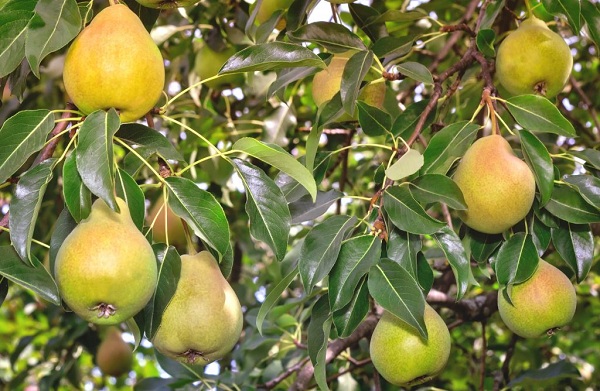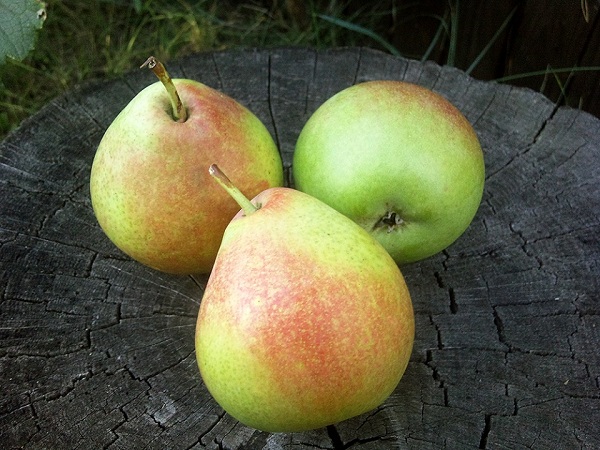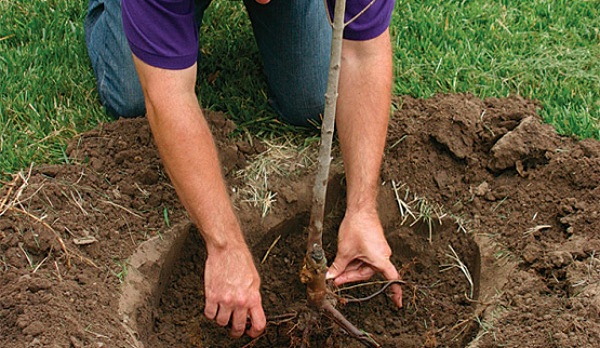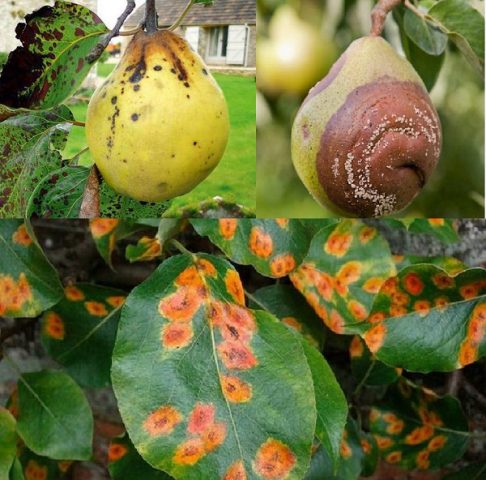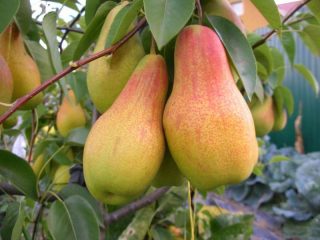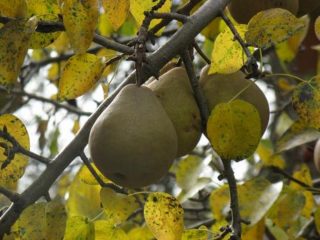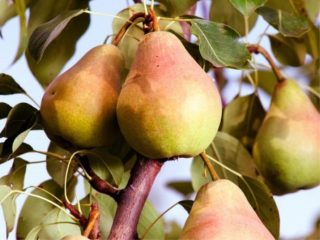Content
Description of the variety pears Elena is fully consistent with the real type of fruit tree. The variety was bred more than half a century ago and only recently began to spread among professional gardeners and agronomists. The pear is famous for its nutrients and attractive presentation. In the process of cultivation, large and juicy fruits are used commercially.
Description pear Elena
In 1960, in the territory of Armenia, the breeder P. Karatyan introduced a new bred pear variety Elena. In the process of crossing, the varieties of fruit trees Lesnaya Krasavitsa and Bere Michurina winter were used. As a result, the Elena variety was bred, which can be cultivated in any part of Russia.
A winter-hardy fruit tree variety has been listed in the State Register since 1990. Now the pear is grown in Armenia, the Central and Southern regions of the country, in the colder regions of Russia. Gardeners consider this variety a dessert, since the tree grows up to 3 m, and the fruits ripen juicy, large. The small growth of the tree allows harvesting without a threat to health.
The crown of a pear is pyramidal with sparse and flexible branches. The foliage is large, with a bright green glossy sheen. The flowering process lasts up to 10 days from late May to June. The flowers are compact, self-pollinated. The first fruits appear after 7 years from the moment the seedling is planted in the ground.
Fruit characteristics
The fruits of the Elena variety are always large, uniform and pear-shaped, ripen by the end of September. There is a bumpy surface, the skin is soft and delicate to the touch, sometimes sticky. The average fruit weight reaches 200 g. Unripe fruits are yellowish-green in color, fully ripe - bright yellow with a pleasant aroma. Gray subcutaneous dots are visible, the peduncle is shortened and slightly curved.
The flesh on the cut is snow-white, oily and juicy. Tasting score - 4.7 points on a five-point scale, you can feel the characteristic sourness and sweet aftertaste. Fruits are eaten fresh, often they make preparations for the winter. The fruits of the Elena variety contain:
- acid - 0.2%;
- sugar - 12.2%;
- fiber and vitamin C - 7.4 mg.
Pros and cons of the Elena variety
Cons of pears are few in number:
- overripe fruit quickly falls off;
- with a large amount of harvest, fruits grow in different shapes;
- average winter hardiness.
Otherwise, the Elena variety has more positive aspects:
- juicy and nutritious fruits;
- resistance to frost and spring frosts;
- high fertility;
- attractive presentation;
- late ripening;
- long shelf life of fruits;
- high resistance to diseases, pests.
Pear fruits are suitable for transportation, but only for short distances. The pear has an average drought resistance, the fruits have a universal purpose in use.
Optimal growing conditions
The fruit tree grows well on black soil in any region of Russia. The climate should be moderately humid. Pear Elena does not tolerate drought well, but abundant sunlight is needed for intensive growth and good ripening of fruits. Some gardeners cultivate a pear in glass greenhouses, but the tree grows up to 2.5 m.In the presented photo, the pear variety Elena is ripe:
Under optimal growing conditions, harvesting of fruits takes up to 10 days. For planting, choose the sunny side of the site with a fence. Groundwater should be at a depth of up to 3-4 m from the roots of the tree. For a seedling, the best planting time is from March to the end of April. During this period, the seedling gets used to the climate and temperature changes, the roots become stronger. The soil must be of low acidity.
Planting and caring for a pear Elena
The planting time of the Elena pear variety largely depends on the climatic conditions of the planting region. In the southern part of the country, it is better to plant in spring, when the first buds are blooming. In the Central region or in the homeland of the fruit tree, the variety is planted in October. Gardeners recommend choosing two-year-old seedlings. Before planting, the tree is immersed in water at room temperature. They are also examined for signs of root cancer. The seedling must have a lot of side shoots, so the rooting of the tree will take place quickly.
Landing rules
2-3 weeks before planting, the site is cleared of excess growth. Dig up the soil, loosen it. The planting hole is dug 70 cm deep, the hole is dug up to 50 cm in diameter. Drainage is poured at the bottom. Part of the excavated soil is mixed with fertilizer, compost and poured with a slide after the drainage layer. If necessary, add sand or lime, which will reduce the acidity of the soil.
The roots are evenly distributed over the pit, if necessary, fill up the earth so that there is no root deepening. Residual soil is also mixed with compost, mineral fertilizers and the seedling is poured layer by layer. After compaction of the soil, a root irrigation ditch is made. Next, the pear is poured with a bucket of water, mulched with dry sawdust or peat.
Watering and feeding
Both a young seedling and an adult Elena variety tree require a large amount of moisture. The soil should not be too wet, you just need to water as the mulch surface dries. In the summer season, the seedling is watered every other day. One adult pear tree requires up to 3 buckets of water.
Before preparing the seedling for winter, the pear is watered abundantly with water. Moisture should get as deep as possible so that the ground does not freeze during frost, and the roots receive nutrients all year round. After wintering, the pear is again poured abundantly with water.
Fertilizing with minerals is carried out every few months from the moment of planting the seedling. In the second year of growth, the first fertilization is done with mineral fertilizers. Growing on black soil, a pear does not require fertilizing, but compost must be added when planting. Closer to winter, phosphates and organic fertilizers are added to the soil.
Pruning
Pruning of branches is carried out in the spring. As soon as the winter is removed, the tree shelter is inspected for the presence of frozen branches. The crown is formed by pruning branches at the initial stage of pear growth. Thinning is done both in winter and in spring.
Whitewash
Whitewashing is carried out before the first frost. A solution of slaked lime will protect the tree bark from sunburn, freezing and severe bark crackling. Mostly whitewashed in autumn, then re-whitewashed in spring. The third time is whitewashed in summer, when the pear is about to bloom. Usually the entire stem is whitened or whitened to the lower skeletal branches. A young tree is whitewashed up to half of the trunk.
Preparing for winter
For winter, the seedling is prepared after all the foliage has fallen off. First, the space is cleared of dead leaves, then it is watered abundantly with water. The readiness of the tree for winter depends on the amount of water received. During the year, with a lack of moisture and a bountiful harvest by winter, the pear will be depleted, so it can hardly tolerate frosts.
Next, pruning is done, diseased, damaged and dry branches are removed. The young seedling is covered with an awning or cloth, the trunk is covered with dry straw. In an adult tree, the trunk is wrapped in burlap or cardboard. The protruding roots are covered with straw, roofing felt or spruce branches.
Pear pollinators Elena
When flowering, pears have flowers of both sexes. Therefore, the tree does not need pollinators. However, to obtain a quality first harvest for the tree, artificial or natural pollinators are used. For pears, varieties of fruit trees are suitable: apple Dubrovka, apple variety Babushkina, Golden excellent, as well as pear varieties Yanvarskaya, Kudesnitsa, Fairy. The flowering of pollinators should coincide in time with the flowering of the Elena pear variety.
Yield
Pear variety Elena of medium yield. With the timely collection of fruits from 1 sq. m gardeners collect up to 40-50 kg. Overripe fruits fall to the ground and lose their presentation due to crumpled sides. Shelf life in a refrigerator is up to 4-5 months at a temperature of + 5-10 ° C. Fruit ripening occurs at the end of September, but, depending on the region of planting, the period varies a month earlier or later. The yield of the Elena variety directly depends on the amount of fertilization and soil moisture.
Diseases and pests
The hybrid has a high resistance to scab and rarely suffers from fungal diseases. Otherwise, it is often attacked by insects. If prophylaxis against diseases and pests is not followed, Elena's pear is sick:
- powdery mildew;
- fruit rot;
- black cancer;
- rust of leaves.
For 50 years of its existence, the hybrid variety Elena proved to be resistant to scab, from which fruit trees often die. From powdery mildew, the foliage of the pear is covered with a white bloom, then the leaves curl up, turn black and die. Fruit rot and black cancer affect fruits that should no longer be eaten. Black cancer can appear with untimely whitewashing, lack of nutrients in the soil. Rust does not do much damage to the pear, but it should not be neglected.
You can also find green aphids, pear mites and tube wrenches, which cause irreparable harm to the fruit tree. In preventive measures against such pests, solutions of diluted sulfur, Bordeaux liquid, soda ash are used. The trees are sprayed 2-3 times per season, when the foliage is completely blooming or the pear begins to bloom.
Reviews about the pear variety Elena
Conclusion
Description of the pear variety Elena and reviews of gardeners prove that the cultivation of this fruit tree guarantees a high-quality harvest. With timely and frequent watering, the tree receives a sufficient amount of nutrient minerals and vitamins, which increases the tree's resistance to attacks by pests and fungal diseases.Pear Elena is unpretentious in terms of soil and climate, so even a beginner in gardening can grow a fruit tree.
